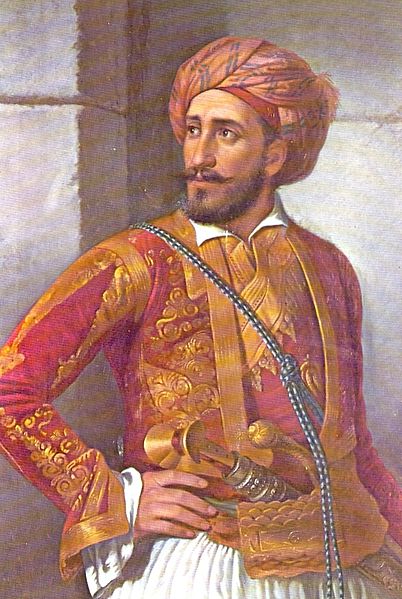Ioannis Makriyannis


 Activity during the Greek War of Independence
Activity during the Greek War of Independence
Under the command of Gogos Bakolas, in September 1821 he took part in the battle of Stavros, near
Tzoumerka, and in the battle of
Peta, where he sustained a light leg injury. A few days later he took part in the siege of Arta that temporarily brought the city under Greek control.
[2] In late 1821, he left for
Mesolonghi, but there, according to his memoirs, he fell seriously ill, only recovering in March 1822.
[2] Having spent his recovery in the village of Sernikaki, near
Salona, he resumed military action, assuming the leadership of a band of warriors from four villages in the vicinity. He fought alongside several other chieftains during the successful siege of
Ypati, which had been fortified with considerable Ottoman forces.
[2]
After the
Acropolis of
Athens was surrendered by the Ottomans in June 1822, Makriyannis was appointed Supervisor of Public Order in the city by the executive authority of Roumeli on 1 January 1823. In that office, he took severe measures aimed at stopping arbitrary oppression of the populace and thievery.
[2] In the summer of 1823, he fought alongside
Nikitaras in the eastern part of
Central Greece. In October 1823, he led a force of Roumeliots in the Peloponnese, and fought alongside the government of
Georgios Kountouriotis against the rebels in the civil war. For his actions during that conflict, he was rewarded with the rank of
brigadier, promoted to
lieutenant general in August 1824 and full general in late 1824.
[2]
In March 1825, after the Peloponnese had been invaded by
Egyptian forces, he was appointed politarch (head of public order) of
Kyparissia and took part in the defence of Neokastro. After the fortress fell on 11 May 1825, he hurried to
Myloi, near
Nafplio, arriving with one hundred men on 10 June. He ordered the construction of makeshift fortifications, as well as the gathering of provisions. More chieftains soon arrived in Myloi and
Ibrahim Pasha, the commander of the Egyptian forces, was unable to take the position, despite numerical superiority and the launching of fierce attacks on 12 and 14 June. Makriyannis was injured during the battle and was carried to Nafplio.
[2]
Soon after the battle, he married the daughter of a prominent Athenian, and his activities were thereafter inextricably linked with that city until his death. After Athens was captured by Ibrahim Pasha in June 1826, Makriyannis helped organise the defence of the Acropolis, and became the provisional commander of the garrison after the death of the commander, Yannis Gouras. He managed to repel a fierce assault against the
Odeon of Herodes Atticus on 7 October, and during the defence of the Acropolis, he sustained heavy injures three times, to the head and to the neck.
[2] These wounds troubled him for the remainder of his life, but they did not dissuade him from taking part in the last phase of the war: in the spring of 1827 he took part in the battles of
Piraeus and the battle of Analatos.
[2]









